Відомі українські художники
План-конспект відкритого уроку вчителя англійської мови ЗОШ І-ІІІ ступенів №7 м. Новогродівки, Донецької області
Литвин Людмили Петрівни
Лютий 2020 рік 10-А клас
Урок
Тема: «Відомі українські художники»
Навчальна тема:
- вчити учнів розповідати та вести бесіду про визначних художників,
- робити опис шедеврів живопису,
- вживати структуру в пасивному стані,
- вчити детального розуміння прочитаного тексту, з повним обсягом зміста.
Розвивальна мета:
- розвивати здібності учнів до слухової і здорової диференціації,
- вміння спілкуватися,
- висловлювати свою точку зору,
Виховна мета:
- прищеплювати любов до мистецтва, виховувати зацікавленість у розширенні своїх знань.
Хід уроку
І. Організаційний момент:
Everyday talk
ІІ. Основний зміст урока:
- Мотивація навчальної діяльності, повідомлення теми, мети і задач уроку.
Ukraine has always been the land of art. Beautiful nature of the country, poetic folk songs, love for the country and kindness of the people encouraged Ukrainian painters to devote their works to these themes.
But at first would you like to tell me what words you use to express your delight. ( Splendid! Great! I can’t believe my eyes! I am so delight! I’m so impressed! I can’t help admiring!)
- Мовна зарядка:
Бесіда T→Ps
- I’m sure the proverb «Art is long, life is short» is well known to everybody. Speak up your opinions on the statement.
- Please, name the genre of the painting you know.
- Translate into English: шедевр, слава, образ, художник, присвячувати, пропагувати, тенденція, представляти, бути натхненим, тема, обстановка, сцена, жанр, зображувати.
- Перевірка домашнього завдання:
Вправа 5, стор.112 (письмово)
Вправа 4, стор 110 (скласти план до текста)
- Монологічне мовлення про етапи розвитку українського мистецтва (за текстом вправи 4, стор 110):
P1 – Cl; P2 - Cl; P3 - Cl; ect ….
- Mach the picture with its painter. (на дошці репродукції картин та імена художників)
- Робота в групах:
а) читання тексту «The museum of Ukrainian Art in Kyiv» (додаток 1)
І group - Read the text and find in it the information about the foundation of the Museum of Ukrainian Art, about the oldest exhibits of the Museum.
II group - Read the text and find in it the information about romantic tendencies in Ukrainian Art, realistic traditions in Ukrainian Art.
III group - Read the text and find in it the information about the 1920s, 30s, 40s years in the development of Ukrainian Art, Soviet Transcarpathian artists.
b) Share the information with other groups.
c) Make up as many questions as you can to this text.
d) контроль питань до текста.
7. Письмо: Passive voice
Put the sentences into the Passive voice
- Unknown artist painted this picture.
- Joseph Turner exhibited his paintings at the Royal Academy.
- You can see some pictures by Aivazovskyi in our Art Museum.
- Only Tetyana Yablonska paints such a beautiful pictures.
- He always paints a lot of sketches when he travels.
- Aivazovskyi painted a lot of landscapes.
8. Контроль засвоєного на уроці.
Бесіда Т →Ps
- What new information have you got in this lesson?
- What activities did you like most of all?
- What do you think of our today’s lesson?
- Did you like it?
9. Підсумок уроку. (рефлексія)
10. Домашнє завдання: виконати вправу 2, стор 114 письмово; опрацювати 5, стор. 112 письмово.
Додаток 1
National Art Museum of Ukraine
In 1994, the museum was given still another name and it became The National Art Museum of Ukraine. In 1999, the one-hundredth anniversary of the first exhibition held at the museum was celebrated, and in 2004, another celebration marked the hundred years since the official opening of the museum. In 2001, the National Art Museum of Ukraine Development Fund was set up by patrons of art.
The museum’s collections now include 37,000 items — icons, paintings, drawings, and sculpture from the medieval times down to our days. The oldest item is the twelfth-century icon of St George with Scenes from His Life. This icon is one of the very few that were preserved since before the Mongol invasion of the thirteenth century.
The icon painting in the seventeenth and eighteenth centuries began to acquire features borrowed from secular art. The traditional saints, martyrs and prominent Christian figures in the icons of those times began to look more like flesh-and-blood characters from life rather than like ascetic representations in line with the established older cannons.
The portrait was a new feature in the Ukrainian art of the seventeenth and eighteenth centuries. The National Art Museum held a large exhibition of Ukrainian portraits of those times within the framework of marking the museum’s hundredth anniversary. The portraits reflect the changing attitudes in the Ukrainian society and new social realities. The portraits of prominent Cossack leaders and wealthy persons who commissioned the portraits, show these people with their attributes of power (mace, orb, and others), and at the same time they are emotionally restrained as in most cases they were to be hung in private chapels in churches. There are still echoes of icon painting in these portraits.
The museum possesses several etchings created by Taras Shevchenko, the poet, painter and pivotal figure of the nineteenth-century Ukrainian culture, from the series known as Picturesque Ukraine.
The end of the nineteenth century and early twentieth century saw an upsurge of interest in Ukrainian culture and flourishing of Ukrainian painting. Such painters as Serhiy Vasylkivsky and Oleksandr Murashko introduced new subjects, new approaches, new visions and new techniques to keep abreast with the latest developments in European painting of those times.
In the late nineteen-tens and nineteen-twenties avant-garde art rapidly developed in Ukrainian painting with such artists as Oleksandra Ekster, Davyd Burlyuk, Kazymir Malevych, Oleksandr Bohomazov, Oleksandr Arkhypenko (in sculpture) and others making their artistic breakthroughs and expanding the boundaries of art. Totally new principles of what art of painting should be were developed and the final rapture with traditions occurred. The work of these Ukrainian artists had an impact on the avant-garde art in Europe and America, and the National Art Museum is a proud owner of many works by the most prominent Ukrainian avant-garde artists.
Heorhy Narbut, a graphic artist of versatile talent, deserves a special mention as a very prominent original figure of Ukrainian art of the first half of the twentieth century. The museum’s collection of his art can be considered quite representational.
The soviet period in the development of Ukrainian art was marked by an almost total suppression of traditional Ukrainian features; ethnic elements were eliminated and replaced by “socialist realism” universal for all soviet art. In spite of the fact that Ukrainian art was subjected to the harshest repression, it survived, and even in the darkest soviet times some artists (Tetyana Yablonska, Serhiy Shyshka, Mykola Hlushkov, Mykhailo Derehus, Heorhy Narbut) managed to create works of high artistic merit worthy to be shown in the museum. Their art reflects the dramatic destiny of talented artists in a totalitarian society.
The new generations of artists have started to come onto the art scene and the museum will surely continue to acquire the best of their works.
Photos have been provided by the National Art Museum of Ukraine

Spring in Ukraine by S. Vasylkivsky.
Oil on canvas. 63 x 117 cm. 1883.
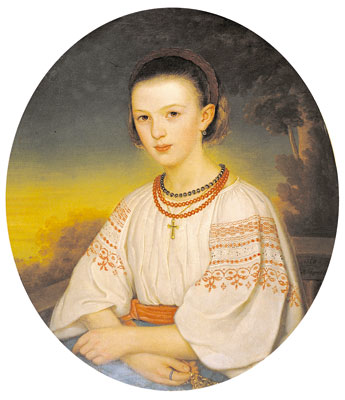
Portrait of Yelizaveta Daragan by M. Bryansky.
Oil on canvas. 72. 5 x 64 cm. 1860.
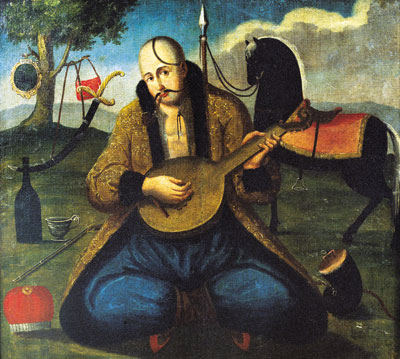
Cossack the bandura-player by an anonymous folk artist.
Oil on canvas. 113 x 104 cm. 19th century.
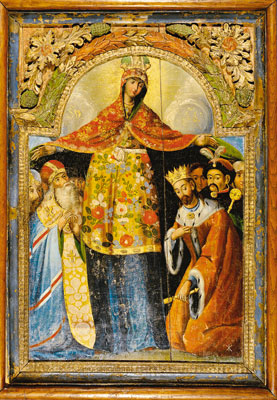
The intercession with the portrait
of Hetman Bohdan Khmelnytsky.
Tempera, oil on wood. 109 x 76 x 4 cm.
The first half of the 18th century.
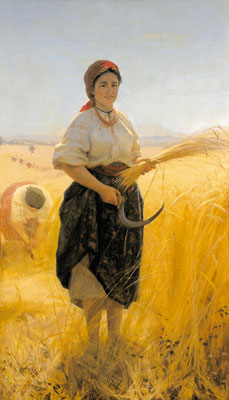
Harvester by M. Pymonenko.
Oil on canvas. 137 x 75 cm. 1889.
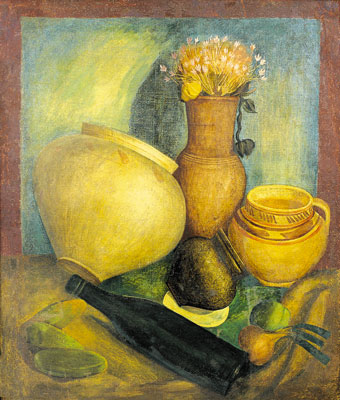
Still life by I. Padalka.
Tempera on canvas. 79 x 67 cm. 1920s.


про публікацію авторської розробки
Додати розробку
